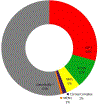Clinical and genetic characterization of pituitary gigantism: an international collaborative study in 208 patients
- PMID: 26187128
- PMCID: PMC6533620
- DOI: 10.1530/ERC-15-0320
Clinical and genetic characterization of pituitary gigantism: an international collaborative study in 208 patients
Abstract
Despite being a classical growth disorder, pituitary gigantism has not been studied previously in a standardized way. We performed a retrospective, multicenter, international study to characterize a large series of pituitary gigantism patients. We included 208 patients (163 males; 78.4%) with growth hormone excess and a current/previous abnormal growth velocity for age or final height >2 s.d. above country normal means. The median onset of rapid growth was 13 years and occurred significantly earlier in females than in males; pituitary adenomas were diagnosed earlier in females than males (15.8 vs 21.5 years respectively). Adenomas were ≥10 mm (i.e., macroadenomas) in 84%, of which extrasellar extension occurred in 77% and invasion in 54%. GH/IGF1 control was achieved in 39% during long-term follow-up. Final height was greater in younger onset patients, with larger tumors and higher GH levels. Later disease control was associated with a greater difference from mid-parental height (r=0.23, P=0.02). AIP mutations occurred in 29%; microduplication at Xq26.3 - X-linked acrogigantism (X-LAG) - occurred in two familial isolated pituitary adenoma kindreds and in ten sporadic patients. Tumor size was not different in X-LAG, AIP mutated and genetically negative patient groups. AIP-mutated and X-LAG patients were significantly younger at onset and diagnosis, but disease control was worse in genetically negative cases. Pituitary gigantism patients are characterized by male predominance and large tumors that are difficult to control. Treatment delay increases final height and symptom burden. AIP mutations and X-LAG explain many cases, but no genetic etiology is seen in >50% of cases.
Keywords: X-linked acrogigantism (X-LAG) syndrome; aryl hydrocarbon receptor interacting protein gene; familial isolated pituitary adenoma (FIPA); gigantism; growth hormone; pituitary adenoma; somatotropinoma.
© 2015 Society for Endocrinology.
Conflict of interest statement
Figures




References
-
- Cheetham T, Davies JH. Investigation and management of short stature. Archives of disease in childhood 2014;99(8):767–771. - PubMed
-
- Batty GD, Shipley MJ, Gunnell D, Huxley R, Kivimaki M, Woodward M, Lee CM, Smith GD. Height, wealth, and health: an overview with new data from three longitudinal studies. Economics and human biology 2009;7(2):137–152. - PubMed
-
- Lee CM, Barzi F, Woodward M, Batty GD, Giles GG, Wong JW, Jamrozik K, Lam TH, Ueshima H, Kim HC, Gu DF, Schooling M, Huxley RR, Asia Pacific Cohort Studies C. Adult height and the risks of cardiovascular disease and major causes of death in the Asia-Pacific region: 21,000 deaths in 510,000 men and women. International journal of epidemiology 2009;38(4):1060–1071. - PubMed
-
- Silventoinen K, Lahelma E, Rahkonen O. Social background, adult body-height and health. International journal of epidemiology 1999;28(5):911–918. - PubMed
-
- Hazebroek-Kampschreur AA, Hofman A, van Dijk AP, van Ling B. Determinants of trunk abnormalities in adolescence. International journal of epidemiology 1994;23(6):1242–1247. - PubMed
Publication types
MeSH terms
Substances
Supplementary concepts
Grants and funding
LinkOut - more resources
Full Text Sources
Other Literature Sources
Medical
Molecular Biology Databases
Miscellaneous

